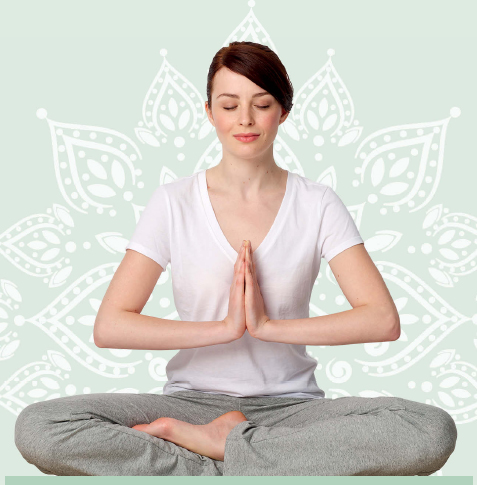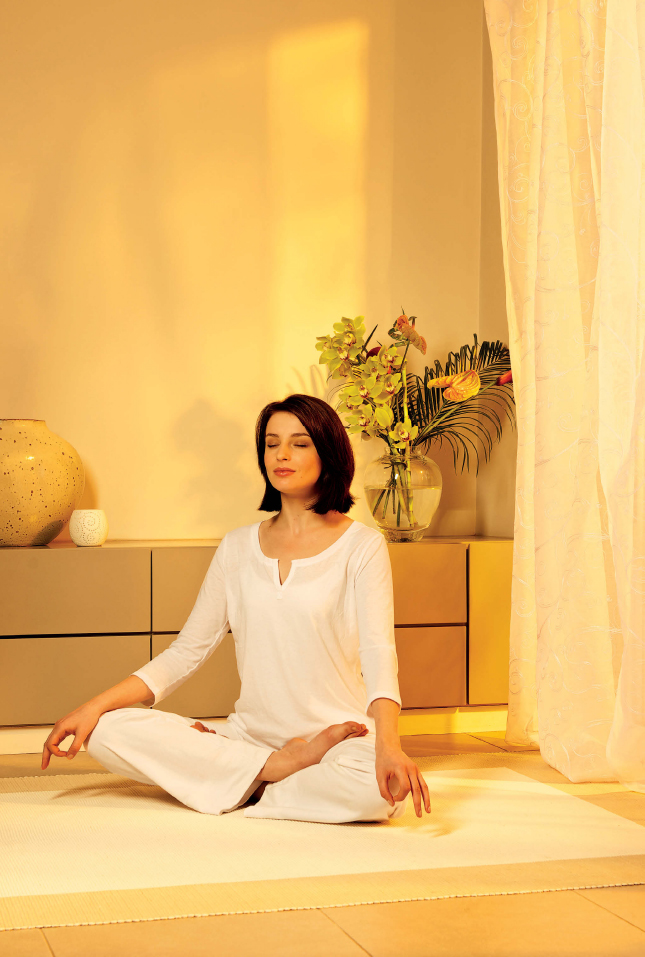

As discussed throughout this book, meditation is the ideal tool to enhance a sense of calm, fulfilment and well-being in your life, and the only way to come to know your true divine nature, which is Sat-Chit-Ananda – ever-existing, ever-conscious, ever-new bliss.
The meditation practices within this chapter have been hand-picked from the Kriya Yoga tradition (see page 12) to help you to move toward these valuable goals.
Firstly, we will explore the key ways of focusing the mind for meditation. Then we will present a range of exercises that will help you to focus your concentration, awaken energy within your spine, tune in to your chakras to promote enhanced flow of prana, and engage with your natural breath in recognition of the fact that you are, in essence, at one with the universe. Finally, we will present the art and practice of Ultimate Bliss Yoga Meditation – the key practice to which all the other exercises in this book have been leading.
If you can do as many of these meditation practices as often as possible – at least three times a week – you will soon be experiencing a deep joy in life that is entirely independent of the external world.
Focusing the mind for effective meditation means not allowing it to become restless or scattered in all directions, and instead holding it to one point of focus. Concentration itself is a narrowing of the field of attention, making the mind one-pointed.
In our current, fast-paced technological age, things often tend to be orientated toward outward action and constant seeking rather than inner reflection. As such, the world keeps our mind and senses continuously active and preoccupied, and we can easily lose any sense of our true identity or our spiritual goal in life.
Meditation is like a bird. It needs two equally strong wings to fly: constant awareness of the spiritual goal of life on one side – realizing that our true inner nature is divine – and a focused mind on the other side. Until you have trained your mind to be free from its habit of continually moving outward, you will make little progress in meditation.
Here follows a grounding in a range of the most effective tools for focusing the mind in order to enhance your Yoga Meditation practice, as well as your quality of life in general. The main techniques are:
• Breathing – in yoga, the breath is the most commonly used tool for focusing the mind. Consider what happens when you concentrate intensely to hear a whisper; your breath stops. This illustrates that our mind and breath are inseparable.
• Visualization – in visualization, sense, object and mind are brought together to form an internal image on which the mind can focus.
• Mantras and chanting – mantras are sacred sounds that have powerful effects on us by focusing our mental energy; chanting mantras draws the mind inward to a focused concentration.
• Steady gazing – concentration on an object such as a candle flame, an Om symbol or a picture of a spiritual master focuses the mind inward.

Opening the heart
Love is the highest state and final goal of spiritual realization. It therefore makes sense that you have to open your heart as well as focus your mind during Yoga Meditation. Without love and devotion, your meditation practice would be mechanical, dry and of little worth. Practising meditation with love and devotion can lead the mind beyond mere intellectual knowledge to an experience of the blissful self, which constitutes true wisdom. For love is the divine within you. Love is your inner source and potential. Love is your true nature.
So how can you cultivate love? Think of a garden: to grow flowers, first you need to create a space. And so it is with love; first you need to clear the tangled weeds of desire, attachment, anger, greed and fear from your heart. The soil of your heart must then be watered and fertilized by cultivating compassion, care and understanding for all. Next, when the tender shoots of service and devotion sprout up, you must keep them free from the insects of selfish egoism.
Just as you can see the moon only by reflected rays of light from the sun, similarly, you can see the divine only through rays of love. By opening your heart and cultivating divine love within you, the dark clouds disperse. Then you will recognize that the same divinity resides in others as in yourself.

A highly effective way to keep your mind in the present moment is to give it the mental object of watching the breath, which is constantly flowing in and out through your nostrils.
You can concentrate on the breath by focusing your attention on the rising and falling of your abdomen, or the expansion and contraction of the ribcage, as you inhale and exhale. The Complete Yogic Breath (see pages 96–7) can help with awareness of this movement.
Alternatively, it can be useful to focus on the sensation of the breath at the point where it enters your nostrils. This is, for example, the basis of the Hong Sau technique (see pages 122–5). In this meditation, you go on to watch the naturally occurring spaces between the breaths, in which the mind becomes very still. By uniting your mind with the breath in this way, the mind will start to stay focused in the present moment.
There are many other ways of working with the breath, such as counting a certain number of breaths in and out, and visualizing it going to certain parts of your body, but all breath techniques work on the same premise of giving the mind a specific object on which to focus.
Visualization is a powerful tool for helping to focus your mind for meditation, whether bringing to mind a calm scene, a visual representation of your prana or chakras, a spiritual guide or any other positive image, as it transports your mind to one particular scene and allows it to sit there, with positive intention.
It is important to be as relaxed as possible when you use visualization. Create the relevant pictures in your mind as vividly as you can. Pay attention to every detail. The more lifelike the visualization, the better the results you will get. But remember that people receive images in different ways. For example, you may receive your impressions through physical sensations, emotions or thoughts rather than pictures. So do not dismiss your impression just because you cannot “see” the images. Your visualization is valid, whatever form the experience may take. For example, sensing the warmth of the sun on your skin, or feeling healing light infusing the cells of your body can be just as useful as visualizing colour and light. Examples within the meditation practices on the following pages that involve visualization are Tratak (see page 113), where you picture a candle flame in your mind in Step 3; and Jyoti Mudra (see pages 128–9), where you are asked to see the inner light of the spiritual eye.

Simple visualization to calm and focus your mind
You can use this simple visualization any time that your thoughts feel scattered and you want to come back into the present moment. Sitting relaxed in a calm, quiet place, begin by taking a few deep breaths to bring your mind to the present moment. Visualize yourself walking barefoot on a beach. It is early evening and the white sand is still warm from the day’s sun. Above, the sky is fading to deep blue. As the sun begins to set, the horizon is streaked with shades of orange, red and purple. Listen to the waves roll in from the sea and break onto the white sand, sparkling and foaming about your feet. Feel the warm, wet sand between your toes. Smell the salt water. Feel the soft breeze from the sea on your skin. Listen to the far-off cry of a seagull. To your left is a large rock. Slowly walk to it, sit down on it and close your eyes. You feel a great sense of peace and tranquillity in the present moment, a feeling of being connected to all life. Enjoy and stay immersed in this inner peace for as long as you can.
Reciting a mantra is one of the most powerful ways of focusing the mind. Deriving from the Sanskrit for “that which protects or liberates the mind”, a mantra is a unique and sacred sound (letter, syllable, word or phrase) that has a radiant energy, which can transform the mind.
Just as a white cloth takes on the colour of the dye in which it is soaked, so does the mind absorb the qualities of the sacred sound vibration of the mantra that is recited. Whether said silently inside your head, whispered or chanted out loud, mantras help to internalize the mind and have the ability to transform the consciousness of the reciter.
The practice of reciting a mantra is called japa (repetition). When you practise correctly, with attentive awareness, japa will gradually calm and integrate your mind, so that your awareness vibrates with the mantra. This naturally leads you into a deeper state of stillness in meditation, where you go beyond the mind to rest in your true divine nature.
When mantras are chanted aloud, the rhythmical vibrations produced by continually repeating them regulate the unsteady vibrations of the five sheaths (see pages 30–33). It is best if such chanting begins aloud, then gradually softens, until it fades into silent, internal chanting.
The source of all sound vibrations, and probably the most well known mantra, is the sacred Primordial Creative Vibration and Divine Power, known as Om or Aum (see page 117). The sincere repetition of Om produces thought waves that correspond to those of the supreme reality. Using the seed mantras related to each of the seven chakras (see pages 118–19) enhances concentration and energy levels. The Hum (pronounced “hoom”) mantra (see pages 120–21) enhances and protects the power of all other mantras, as well as having a fiery energy that destroys negativity. And the Hong Sau mantra (see pages 122–5) calms the mind and helps to awaken the energy in your chakras. Whatever the mantra used, it will help the mind to turn inward and therefore become much more calm.
The following concentration exercise, known as Tratak, can be done any time. It steadies the wandering mind and enhances willpower. The Sanskrit word Tratak means “to gaze continuously at an object without blinking”. Here we suggest gazing at a flame, but you could use any other object with positive associations.
1 Sit in a comfortable meditation posture in a darkened room, with a lighted candle about an arm’s length in front of you, at about chest height.
2 Fix both your gaze and mental focus at the mid-point of the flame where it is brightest for as long as possible without blinking, until your eyes begin to become tired. At the start, practise only for about one minute, then increase to a few minutes over a period of time.
3 End by closing your eyes and visualizing the flame internally in the space between your eyebrows for one minute. Then, repeat the whole process two more times. When you have finished your practice, rub your palms together until they are warm. Place them over your eyes to relax and soothe them. Then, when you feel ready, lower your hands.
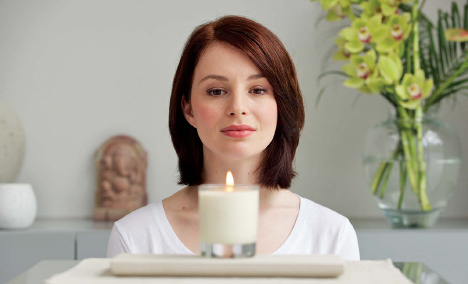
When practised properly, the powerful Hatha Yoga technique of Maha Mudra (meaning “great gesture” in Sanskrit) provides not only a range of physical benefits, such as stimulating digestion and easing constipation, but also balances and opens the ida and pingala nadis (see pages 44–5), encouraging the life-force to flow upward in the central nadi, the sushumna.
When the right big toe is grasped in Stage 1 of Maha Mudra (see right), pingala nadi is opened and activated. And when the left big toe is grasped in Stage 2 (see page 116), ida nadi is opened and activated. When both toes are pulled simultaneously in Stage 3, the spine becomes magnetized with prana flowing into the sushumna, which will bring deeper awareness and concentration to your meditation.
NOTE: The version of Maha Mudra presented on pages 115–117 includes a knee position slightly modified from the traditional Hatha Yoga version in that it does not require a rotation. If you have any problems with your knee, you may therefore find this posture easier to practise.

Benefits of bandhas
The two bandhas – Mula Bandha and Jalandhara Bandha (see pages 60–61) – that are held as part of Maha Mudra retain energy in the spine, so that the energy can be directed upward into the higher centres in the brain leading to an increased sense of vitality and balance.

1 Sit upright with your head, neck and spine aligned and your legs stretched out in front of you. Bend your left leg with the knee pointing forward and sit on your left foot, with the heel pressing against the perineum (between the genitals and anus) forming an anal lock (Mula Bandha; see page 60). Breathe in Ujjayi breath (see pages 98–9) if you are familiar with it, or breathe normally if not.

2 Bend your right leg and place the foot flat on the floor. Then, interlocking the fingers of both hands together, stretch forward, clasp your hands around your right knee and draw the thigh in against your torso, or as close as possible. Keep your spine straight in this position, inhale slowly to a count of ten to 15 and feel that you are drawing a cool current of prana up your spine.

3 Then, holding the breath, stretch your right leg out in front of you, bend forward, and with interlocked hands, grasp your big toe and gently pull, so that you extend your trunk forward and your forehead toward the knee. If this is uncomfortable, bend the knee slightly. The important thing is to feel the spine stretching and a sensation of energy rising through it. As you do so, bring your chin toward your neck to apply the throat lock (Jalandhara Bandha; see page 61), and with your attention at your spiritual eye, or ajna chakra, between your eyes (see page 40), mentally chant Om six to 12 times. Feel a sensation of energy rising up through the spine and pulsating at your spiritual eye, radiating waves of bliss through the brain.

4 Release the throat lock, move your clasped hands to just below your right knee and draw your knee back up against your torso, while slowly exhaling to a count of ten to 15. With your awareness in your spine, feel that you are drawing a warm current of energy down through it.
Stage 2

Now change sides and repeat Stage 1, starting by tucking your right foot under and pulling your left knee to the torso with your clasped hands.
Stage 3


1 Sit upright with your knees bent and clasp your hands (fingers interlocked) around your knees, pulling your thighs against your torso. Inhale for a slow count of ten to 15, feeling that you are drawing a cool current of prana up the spine.

2 Now, holding your breath, stretch both legs out together in front of you, grasp your big toes with your interlocked hands and pull on them, stretching your torso forward and feeling the stretch in your spine. Apply the throat lock again and bring your forehead toward your knees. Meanwhile, focus your attention at your spiritual eye, between the eyebrows, and mentally chant Om six to 12 times. You may feel a sensation of energy rising up through the spine followed by pulsating at the spiritual eye, resulting in waves of bliss radiating throughout the brain.

3 Release the throat lock and slowly exhale to a count of ten to 15. Keeping your awareness in the spine, see if you feel a warm current of pranic energy flowing down the spine. Then bring your knees and thighs back up against your torso, by pulling on the knees with clasped hands. Relax and return to normal breathing.
These three stages complete one round of Maha Mudra. Practise three complete rounds. As you progress with this practice, you may increase the number of rounds to 12.

Significance and pronunciation of Om
The primal vibratory sound Om (see also pages 130–33) helps to awaken energy in the spine and stimulate the brain cells when chanted. When the word is sounded it is Om. In this exercise, the correct pronunciation of Om is like a long, drawn-out version of “home” without pronouncing the “h”. Give equal measure to both the “o” and “m” sounds, and close with the sound “mmm”. However, it is also occasionally written as Aum. The three separate letter sounds in this variant represent the three states of consciousness, as well as the divine trinity of Brahma, Vishnu and Shiva.
As explored on page 112, chanting is an effective way to enhance energy throughout the body, as well as to focus the mind. The meditation practice opposite activates the chakras using the sound vibration of the particular mantras associated with each one. These are known as bija or seed mantras. Each “seed” mantra clears its chakra of any blockages so that it can function efficiently, allowing you to reach a deeper meditative state. Below are the seed mantras and musical notes (if you choose to sing them) for the first six chakras. The seventh chakra, sahasrara (crown) chakra is not included as the other six need to be cleared first in order to access the ineffable experience of the seventh chakra. It is important to pronounce all the mantras in the list containing an “a” with a long “aaa” sound.
| CHAKRA | LOCATION | SEED MANTRA | MUSICAL NOTE |
AJNA |
forehead | Om | F |
VISHUDDHI |
throat | Ham | E flat |
ANAHATA |
heart | Ya m | D |
MANIPURA |
navel | Ram | B flat |
SVADHISTHANA |
genital area | Vam | A |
MULADHARA |
base of spine | Lam | G |

1 Sit in your choice of comfortable meditation posture (see page 52–7) with your head, neck and spine aligned. Close your eyes.
2 Bring your awareness to your muladhara chakra, located at the base of the spine. Inhale deeply and as you exhale, repeatedly chant aloud the bija mantra “Lam”. Feel the mantra vibrating at the chakra as you chant “Lam, Lam, Lam” for as long as your exhalation lasts.
3 Next, bring your awareness to the second chakra, svadhisthana, located at the genital area. Inhale deeply and as you exhale, chant the bija mantra “Vam”. Feel the mantra vibrating at the svadhisthana chakra.
4 Slowly work your way through the other chakras on the chart opposite, chanting the corresponding seed mantra and feeling the vibration at the relevant chakra centre each time you do so.
5 Once you have completed your chanting, focusing on the ajna chakra, start working your way through the list in reverse order, chanting each seed mantra again while focusing on the related chakra area. Start with “Om” for a second time at the ajna chakra, and finish with “Lam” at muladhara chakra.

Mentally chanting the bija mantra
The exercise above can also be done by chanting each seed mantra internally instead of out loud. Inwardly chanting the mantras through the chakras places more emphasis on the calming, meditative effect of the practice, while chanting them aloud puts more emphasis on its vibrant, energizing aspect.
It is said that the Hindu god Lord Shiva used the Hum mantra (pronounced “hoom”) to project fire from his third eye in order to burn desires and negativity. This mantra therefore brings a fire energy and power to all who chant it by helping to increase prana in the body and to activate the potent life-force known as kundalini. This helps to combat any negative feelings, as well as easing fatigue and lethargy.
In the exercise that follows, the Hum mantra is chanted after a chakra’s seed mantra, in order to enhance its energy. Then, by adding Om at the start of a seed mantra, you can make it even more effective for opening the mind for deep meditation. The exercise opposite can either be done after the bija mantra exercise (see page 119) or as a technique in its own right.
| CHAKRA | LOCATION | MANTRA | MUSICAL NOTE |
AJNA |
forehead | Om Ksham Hum | F |
VISHUDDHI |
throat | Om Ham Hum | E flat |
ANAHATA |
heart | Om Yam Hum | D |
MANIPURA |
navel | Om Ram Hum | B flat |
SVADHISTHANA |
genital area | Om Vam Hum | A |
MULADHARA |
base of spine | Om Lam Hum | G |
Practising the Hum mantra

1 Sit in your choice of comfortable meditation posture (see pages 52–7) with your eyes closed and focus your awareness at the point between your eyebrows, known as your spiritual eye.
2 Transfer your awareness to muladhara chakra, at the base of your spine, and chant aloud the mantra “Om Lam Hum” six to nine times, feeling it resonating at the site of this chakra. Sit quietly and continue to feel the vibration of the mantra even when you stop the actual chanting.
3 Next, transfer your awareness to your svadhisthana chakra at the genital area, and chant aloud the mantra “Om Vam Hum” six to nine times, feeling it resonating there. Again, sit quietly and sense the vibration of the mantra once when you stop the actual chanting.
4 Slowly work your way through the other chakras shown opposite, chanting the corresponding mantra each time, and feeling the vibration at the location of the chakra. Be sure to pause for a short silence between each mantra.
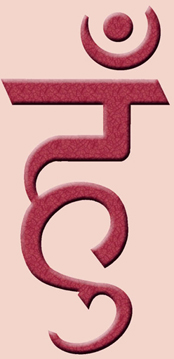
NOTE: Lam, Vam, Ram, Yam, Ham and Ksham should be sounded with a long “aaa” sound. Om should be sounded as “ong”. Hum should be sounded as “hoom”.
Hong Sau (pronounced “Hong Saw”) is an ancient Sanskrit mantra for calming the mind and deepening concentration. Repetition of this mantra stills restless thoughts, withdraws the mind from the senses and calms prana in the body. Hong Sau means “I am He” or “I, the manifest self, am He, the Absolute.” By internally repeating Hong Sau in harmony with your breathing during meditation – hong on the inhalation and sau on the exhalation – you affirm that the individual self is one with the Infinite Spirit.
Hong Sau is considered to be the natural, subtle sound of the breath:
• Hong vibrates with the inhalation, representing the contraction of consciousness and corresponds to the ascending current in the ida nadi (see pages 44–5)
• Sau vibrates with the exhalation, representing the expansion of consciousness into pure unity and corresponds to the descending current in the pingala nadi.
Over the course of 24 hours, the breath is said to flow in and out 21,600 times in a continuous mantra of Hong Sau. In yoga, such continuous subconscious recitation is called ajapa-japa, while japa is the term used to describe the conscious mental recitation in the technique that follows.
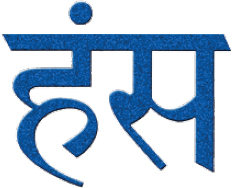
Hong Sau preparation

As well as forming a useful calming sequence in its own right, the steps below will prepare both your body and your mind for the Hong Sau technique on the next page.
1 Sit in your choice of comfortable meditation posture (see pages 52–7) with your head, neck and spine aligned. Inhale deeply, hold the breath and tense all the muscles in your body. Hold both the breath and the tension in your muscles for a few seconds, then simultaneously release them and relax. Repeat the process of tensing and relaxing three times.
2 Continue to remain relaxed as you practise what is called Loma Pranayama: a three-part equal-breath-ratio exercise, breathing through both nostrils. Inhale for a count of 12, hold your breath for a count of 12, exhale for a count of 12 (12:12:12). If this is not within your lung capacity, halve the counts to six. Do this nine times at first and gradually increase over a period of time to anything up to 27 rounds.
3 Now concentrate your relaxed attention at the point between your eyebrows (your spiritual eye, or ajna chakra; see page 40). Let go of all thoughts and be totally centred in the present moment. Place your hands, palms upward, on your knees in Chin Mudra (see page 58), close your eyes and place your focus on your natural breath, as you inhale and exhale, inhale and exhale … If your mind wanders, gently bring it back to the practice of watching your breath with awareness.
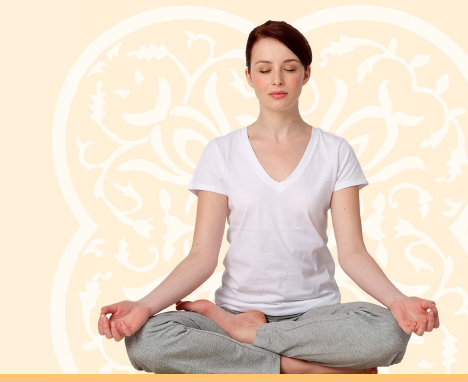
Hong Sau technique

1 Now with your body and mind still, and your eyes closed, gently lift your gaze upward to the point between the eyebrows, and look calmly into your spiritual eye, or ajna chakra – the seat of your intuition and of omnipresent perception.
2 Feel the natural breath flow in and out of your nostrils and try to establish the point where it feels strongest. Once you have found this point (usually just inside the tip of the nose), observe the breath that passes it with precision, one split second after another. In this way, continuous awareness will eventually result.
3 Then begin to feel the sensation of the air higher in the nostrils, up by the point between your eyebrows, and focus on this area. As your concentration deepens, your breathing will begin to slow down, and you will be able to focus on it more clearly, with fewer interruptions.
4 Inhale deeply, then slowly exhale. As the next inhalation naturally flows into your nostrils, feel the breath where it enters, and with your inner focus, mentally follow the breath with the mantra Hong. Imagine that the breath itself is making this sound.
5 As your breath flows out naturally, mentally follow it with the mantra Sau (pronounced “saw”). Once again, feel that your subtle breathing is silently making the sound of its own accord.
6 Continuing to focus on your spiritual eye, between your eyebrows, mentally follow each inhalation with the mantra Hong, and each exhalation with the mantra Sau. When the mind is united with the flow of the breath, you will be able to truly experience the present moment.
7 As you go deeper into this practice, you may notice that there is a natural space or pause, a point of complete stillness, between each inhalation and exhalation. This is the space of the innermost Self. Softly focus your awareness on these pauses. As your mind becomes more calm, notice the spaces extending and enjoy the experience of expansion while inwardly gazing into your spiritual eye. Then, when the breath naturally returns, continue with the practice of Hong Sau for as long as it feels natural, or in the beginning up to 15 minutes.
8 Once you finish, try to maintain a sense of that inner space from your meditation for as long as possible, allowing the calmness to permeate your everyday consciousness.
NOTE: It is important to make no attempt to control the breath during the Hong Sau technique. This is not a yoga breathing exercise. It is simply a matter of being consciously aware of the breath, with your concentration on the Hong Sau mantra.

The spiritual eye of intuitive perception
In deep meditation it is possible to naturally see and experience the gold-, blue-, and white-coloured light of the spiritual eye, or ajna chakra. But while you are working toward this, you might want to try visualizing it in order to add another dimension to your meditation:
• An outer gold ring of light represents cosmic energy.
• A sphere of blue light represents the omnipresent intelligence of the divine in creation.
• A central silver-white star represents infinite spirit or cosmic consciousness, a doorway to the infinite.
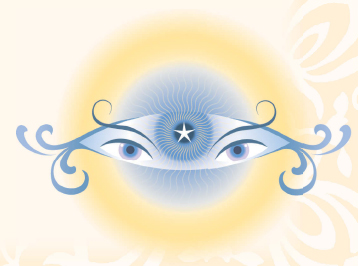
Navi Kriya (pronounced as “Nabi Kriya”) is one of the original Kriya Yoga techniques, taught by Lahiri Mahasaya, who learned the supreme science of Kriya Yoga meditation from Mahavatar Babaji, the great Himalayan yogi (see page 12).
The purpose of this Yoga Meditation technique is to stimulate and awaken the prana at manipura chakra, in the navel centre, and draw the energy from here up the spine to the spiritual eye, or ajna chakra, elevating your consciousness above the lower chakras to access a more meditative state. It is essential to be established in ajna chakra before you can be liberated in sahasrara, the crown chakra at the top of the head.
Practising Navi Kriya

1 Sit in your choice of comfortable meditation position (see pages 52–7) with your head, neck and spine aligned. Relax your whole body, close your eyes and bring your attention for a moment to the point between the eyebrows, at your spiritual eye, or ajna chakra.
2 Then bring your awareness to muladhara chakra, at the base of your spine, and slowly inhale and mentally chant Om as if you were sending the mantra’s energy into this chakra.
3 Repeat this internal chanting of the mantra Om at each of your ascending chakras in succession, sending the energy there each time:
• svadhisthana – at the genital area
• manipura – at your navel
• anahata – at your heart
• vishuddhi – at your throat
• the medulla oblongata – the negative pole of ajna chakra (see page 40), which is located at the back of your head, below the base or rear of the brain
• the spiritual eye chakra (positive pole of ajna chakra), which is located between your eyebrows.
4 Slowly tilt your chin down towards your neck, forming a throat lock (see page 61), and bring your awareness to manipura chakra at your navel.
5 As you continue to breathe normally, mentally chant Om 100 times to activate this chakra and bring energy up from the lower two chakras: muladhara and svadhisthana. A calm energy is usually perceived gathering around the navel; this is the prana current called samana vayu guiding your prana into the subtle sushumna channel (see page 44).
6 Maintaining your awareness at manipura chakra, and with your inner gaze at the point between your eyebrows, release the throat lock, raise your chin to the upright position, and slowly tilt your head back as far as is comfortable without strain. See if you can feel your energy moving into the area at the base of your skull known as the medulla oblongata, and then back down through your spine to manipura chakra at your navel centre.
7 Holding your head back in this tilted position, mentally chant Om 25 times, directing the mantra’s energy into the counterpoint of the navel on the back of your spine.
8 Now slowly raise your head to its normal position, and with concentration, once again mentally chant Om successively at each of the six chakras, this time starting at the ajna chakra and moving downward: ajna, vishuddhi, anahata, manipura, svadhisthana and muladhara chakras.
9 This completes one round of Navi Kriya. Aim to practise six to 12 rounds, then sit quietly for a few moments with your inward attention at your spiritual eye. When you return to your normal activities, carry this natural sense of inner stillness and energy with you to give you the inner strength to overcome life’s trials and tribulations.
Jyoti Mudra – meaning “gesture of light” – is a technique by which you can enhance your sense of inner peace and wisdom by focusing on the inner light that radiates from the spiritual eye, or ajna chakra (see also page 40). In Yogic texts this mudra is commonly referred to as Yoni Mudra, the Sanskrit word yoni denoting the womb of creation because, like the baby in the womb, anyone practising Yoni Mudra becomes undistracted by the external world. Jyoti Mudra can be practised at any time, but the best time is in the calm of the late evening or night. This time is ideal for turning inwards and away from the noise and distraction of the workaday routine.
CAUTION: Do not put pressure on the eyes while holding Jyoti Mudra – keep light and gentle pressure to avoid causing harm to this sensitive area.

The sense openings in the face are closed in Jyoti Mudra, with the ears, eyes, nose and lips all held gently but firmly shut.
Practising Jyoti Mudra

1 Sit in your choice of comfortable meditation posture (see pages 52–7) with your head, neck and spine aligned. Relax your whole body, close your eyes and bring your attention to the point between your eyebrows.
2 Inhale slowly to a mental count of ten to 12, focusing on feeling a current of prana rise up through your spine. As you do so, raise your arms up to your face, with your elbows parallel to the floor and pointing sideways.
3 At the end of the inhalation, hold your breath and focus on centering the prana you have drawn up your spine at your spiritual eye (see page 40).
4 Then place your fingers in Jyoti Mudra which involves closing off all the sense openings in your head: close your ears by pressing the ear flaps with your thumbs; gently hold your eyes closed by placing the index fingers on the corners of your eyelids; close your nostrils with your middle fingers; and gently squeeze your mouth shut by placing your ring fingers above the lips and your little fingers below the lips (fingertips should be touching each other).
5 While holding Jyoti Mudra, turn your gaze in toward the spiritual eye and feel that your fingers are directing your prana there. See if you can perceive its inner light and allow yourself to merge into it.
6 Holding your breath, internally repeat the mantra Om, directing the energy of the chant to the point between your eyebrows. See if you can see the light gathering and intensifying into a golden ring that expands to surround a sphere of deep-blue light with a silvery-white star at its centre (see box page 125).
7 Then remove your fingers and thumbs from the sense openings, keeping them gently resting on your face so that you are ready for another round.
8 Finally, exhale slowly to a mental count of ten to 12, focusing on feeling a current of prana descend through the spine to muladhara chakra.
This completes one round of Jyoti Mudra. Practise three rounds in total. Sit in meditative stillness, enjoying the soothing experience of this gesture.
The sacred Sanskrit mantra Om, otherwise known as the Primal Sound or the Cosmic Vibration, is thought to represent the energy behind all creation. Said to contain within itself all language, letters, sounds and other mantras, its sound vibration represents union with the divine, making it the link between human consciousness and divine cosmic consciousness.
The beauty of the mantra Om is that it provides us with a concrete representation and experience (via sound) of what would otherwise be a difficult-to-grasp, purely abstract concept: that of the absolute, supreme reality, divine cosmic consciousness or ultimate bliss, with which we all strive to attain union. In yogic terms, this state of union is called samadhi and is the goal of Yoga Meditation.
The repetition (japa; see page 112) of Om is believed to produce thought waves that correspond to those of the supreme reality. So when it is chanted with faith, devotion and reverence over a sustained period of time, it encourages awareness of the presence of the divine within. As such, it is a gateway to your true divine and contented Self, a means of awakening your inner spirit and allowing you to feel more connected and at peace with yourself and the world – with an increased sense of clarity, ease and joy.
In the sacred Hindu text Upanishad, the mantra Om is described as “resplendent humming”. In deep meditation this inner sound is so prominent that it drowns out all external sounds and manifests the inner sounds of the chakras, which are vibrating at different frequencies and therefore have different manifestations (see below). The meditation on pages 132-3 gives you the chance to experience these.
MULADHARA CHAKRA – Like the humming or drone of bees. A low vibratory sound. When heard less perfectly it may sound like a motor or a drum.
SVADHISTHANA CHAKRA – Like a flute. When heard less perfectly it may sound like running water or the noise made by crickets’ wings beating together.
MANIPURA CHAKRA – Like a stringed instrument such as a sitar or a harp.
ANAHATA CHAKRA – Like the flowing peal of deep bells or a gong. When heard less perfectly it sounds like tinkling bells.
VISHUDDHI CHAKRA – Like thunder or the roar of the ocean. When heard less perfectly it may sound like the wind or a waterfall.
AJNA CHAKRA (spiritual eye/medulla oblongata) – A symphony of sounds, which is Om, the source of all sounds.
The Om meditation that follows will help you to inwardly attune to the vibratory sound of divine cosmic consciousness, thus creating a sense of inner stillness and oneness with the world around you. It is particularly good to do it during the peaceful evening period, when your mind is more calm and focused.
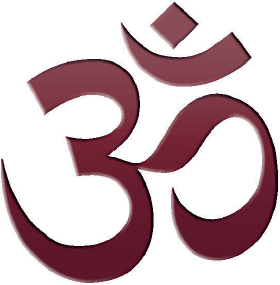
“The sacred word Om expresses the supreme being. Constant repetition of Om and meditation on its meaning leads to samadhi.”
Yoga Sutras 1:27–28

Before you practise the Om meditation technique, begin with three rounds of Maha Mudra (see pages 114–17), a few rounds of Nadi Shodhana (see pages 86–7) and the Hong Sau technique (see pages 122–5) for 10–15 minutes, or until you feel a sense of inner calm. It is best to have been practising Hong Sau for at least three months in order to have settled the mind and achieved deeper levels of concentration before regularly practising this Om meditation.
1 Sit in your choice of comfortable meditation posture (see pages 52–7), with your head, neck and spine aligned. Place your upper arms on a suitable armrest or sit with your knees together, pulled up against your chest, and rest your elbows on your knees. Your arms and shoulders should be at a comfortable height, with no strain on your hands, arms, back or neck. When using an armrest, make sure your upper arms are resting parallel to the floor with your elbows in line with your shoulders (see page 148).
2 Raise your hands up to your head and position your fingers on your face in Jyoti Mudra: close your ears by gently pressing the ear flaps with your thumbs; gently close your eyes by placing your little fingers lightly on the outer corners of each eyelid; and rest your other fingers diagonally upward and inward on your forehead to direct energy toward the spiritual eye or ajna chakra.
3 Holding your fingers in this position, gaze with deep awareness into your spiritual eye, between your eyebrows. Then start internally chanting “Om, Om, Om”, directing it at the spiritual eye, so that the mantra vibrates and resonates there. The correct pronunciation of Om here, the symbol of the Supreme Lord, is like the letter “o” in the alphabet but drawn out, closing with the sound “mmm”. In other words, it should sound like a long, drawn-out version of the word “home” without pronouncing the “h”. Equal measure should be given to both the “o” and “m” sounds.
4 As you continue to chant, simultaneously listen in your right ear for the subtle sound frequencies of your chakras, as the right ear is more receptive to spiritual vibrations. If you hear a distinct sound like any of those described on pages 130–131, focus your awareness totally on that. If at first you hear only your own heartbeat and breathing, then concentrate on those sounds. Over time, your mind will gradually turn inward and become calm so that you will begin to hear the more subtle sounds of the chakras.
5 As sensitivity develops, you are likely to hear a fainter sound behind the first one, so transfer your awareness to that. Soon, a third sound is likely to emerge behind the second, so transfer your awareness to that.
6 Continue discarding each grosser sound for the more subtle one that you hear. Your aim is to reach the source of all sound, related to your spiritual eye, or ajna chakra – the Primordial Vibratory Sound, Om. Although you are mentally chanting Om to keep your mind inwardly focused, it should not become a distraction from your main concentration of listening for the subtle sounds within.
7 Firstly, listen out for the Om sound in your right ear, later both ears, until you feel like it is coming from the centre of your brain. Then, feel it gradually descending to permeate every cell in your body and expanding outward. As your experience of this Om sound deepens, your consciousness expands, and you will begin to feel omnipresent, beyond the ego, mind, body and senses.
8 After listening to the inner sound vibration of Om for ten to 20 minutes, remain sitting for a while, enjoying the joyful stillness of your meditation and a deep sense of being at one with yourself.
This is the meditation to which all other Yoga Meditation practices in this book have been leading, the one in which everything comes together. The asanas (postures) have brought strength and steadiness so that you can sit, relaxed and still, for a long enough period of time. The purification practices have cleansed your subtle energy channels (nadis), helping to remove the obstacles that stop you from experiencing and realizing the divine within you. The pranayama (breathing techniques) have helped you gain mastery over your mind by gaining control over your vital internal energy. The meditation practices have helped to direct energy up through the chakras in the astral spine, calmed the mind and allowed you to experience the inner divine light within your own body.
Combined, all the practices should have helped to:
• disconnect your mind from the outward senses and the sensory objects of distraction they bring into your consciousness
• interiorize and regulate your mind and heart through self-discipline
• direct your body’s vital life-force, or prana, up through the astral spine from the lower to the higher chakras
• focus your energy at the spiritual eye, or ajna chakra, to allow an experience of the divine inner self.
The aim of this final meditation is to raise your prana to the highest of the body’s energy centres, known as sahasrara chakra, where your individual soul can truly become one with the supreme consciousness through the process of samadhi (divine union; see page 27) – so you can experience that lasting absolute pure joy and contentment within you, which is attained only through deep meditation.
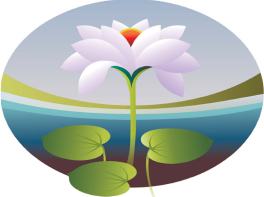
Practising Ultimate Bliss Yoga Meditation

1 Sit in your choice of comfortable meditation posture (see pages 52–7), with your head, neck and spine aligned. Inhale deeply through your nose. Hold your breath and tense all the muscles in your body. Then, with a deep double exhalation through the mouth (“ha-haaa”), relax your whole body. Repeat this three times in total.
2 Remain still here, feeling the energy flowing through your body, and take a few silent moments to invoke the presence of the divine by saying something internally along the lines of: “May divine grace enliven my body, mind and spirit, and inspire, bless and guide my meditation, filling me with inner clarity, love, peace and joy.”
3 Close your eyes and gently sway your spine from left to right, shifting the centre of your consciousness from the physical body and senses to your inner astral spine, imagining it like a hollow tube filled with vital, flowing energy. Once you can sense this subtle energy, stop swaying.
4 Focus your inner gaze at the midpoint between your eyebrows, at your centre of spiritual consciousness called the spiritual eye. And become aware of your breath’s natural rhythm. Do not try to control it in any way, just be aware of each breath as it flows in and out. Notice where each inhalation and exhalation arises and dissolves.
5 Focus your attention on your own awareness, as if you are being attentive to attention itself. By doing so, try to become aware of the part of you that is witnessing your meditative experience – your true inner self.
6 Now breathe in deeply using Ujjayi breathing (see pages 98–9) to a count of ten to 15, with the air directed in the back of your throat so that it is slightly expanded to create a suction effect. (If you are not yet at ease with Ujjayi breathing, keep practising it, and simply breathe normally here for now.) As you inhale, be aware of a cool sensation in your throat and try to transfer that sensation up your astral spine to the medulla oblongata and across to your spiritual eye.
7 Hold your breath here for the count of three internal Om chants.
8 Next, exhale slowly and deeply with Ujjayi breathing (if you are familiar with it) to a count of ten to 15, being aware of the warm sensation of the breath as it moves down through the spine from your eyebrow centre to the base of your spine.
9 Then, without a pause, begin to inhale up your spine again. Practise 12 cycles of this deep breathing up and down your spine until you feel your spine vibrating and pulsating with energy.
10 Then allow your breathing to return to its normal pattern and just be aware of your energy moving up and down, deep within your spine. Follow the movement of your breath and listen carefully to the inner sound it makes.
11 As you breathe in and the energy moves up your spine, internally repeat Hong. As you breathe out and the energy moves down your spine, internally repeat Sau.
12 With attentive focus listen to the Hong on each inhalation and the Sau on each exhalation. Merge your attention with the flow of breath and identify yourself more and more with the vibration of the mantra. To do this, try to visualize the Hong Sau mantra as light or energy and feel yourself immersed in it until you feel you have become one with it and are blessed by it.
13 Mentally affirm: “I am spirit, I am pure I-awareness, the ever-Existing, ever-conscious, ever-blissful Self.”
14 Then remain in the blissful stillness of the meditative space you have created for as long as you naturally can, enjoying the expansion of consciousness and sense of oneness with the divine.
15 When you are ready, return to normal breathing and gradually become aware of the sensations in your physical body. Then place your hands together in prayer position in front of your heart and offer thanks to the source of the divine within you – for grace, blessings, energy and power.
16 Chant Om Shanti (a mantra for peace) three times to send peace and love to all beings in the universe. Let every breath that flows from you create a strong current of divine service to all beings.
17 Slowly open your eyes, then remain quietly seated for a short while to enjoy the sense of peace from your meditation. Allow this inner calm and contentedness to permeate into your everyday consciousness.
